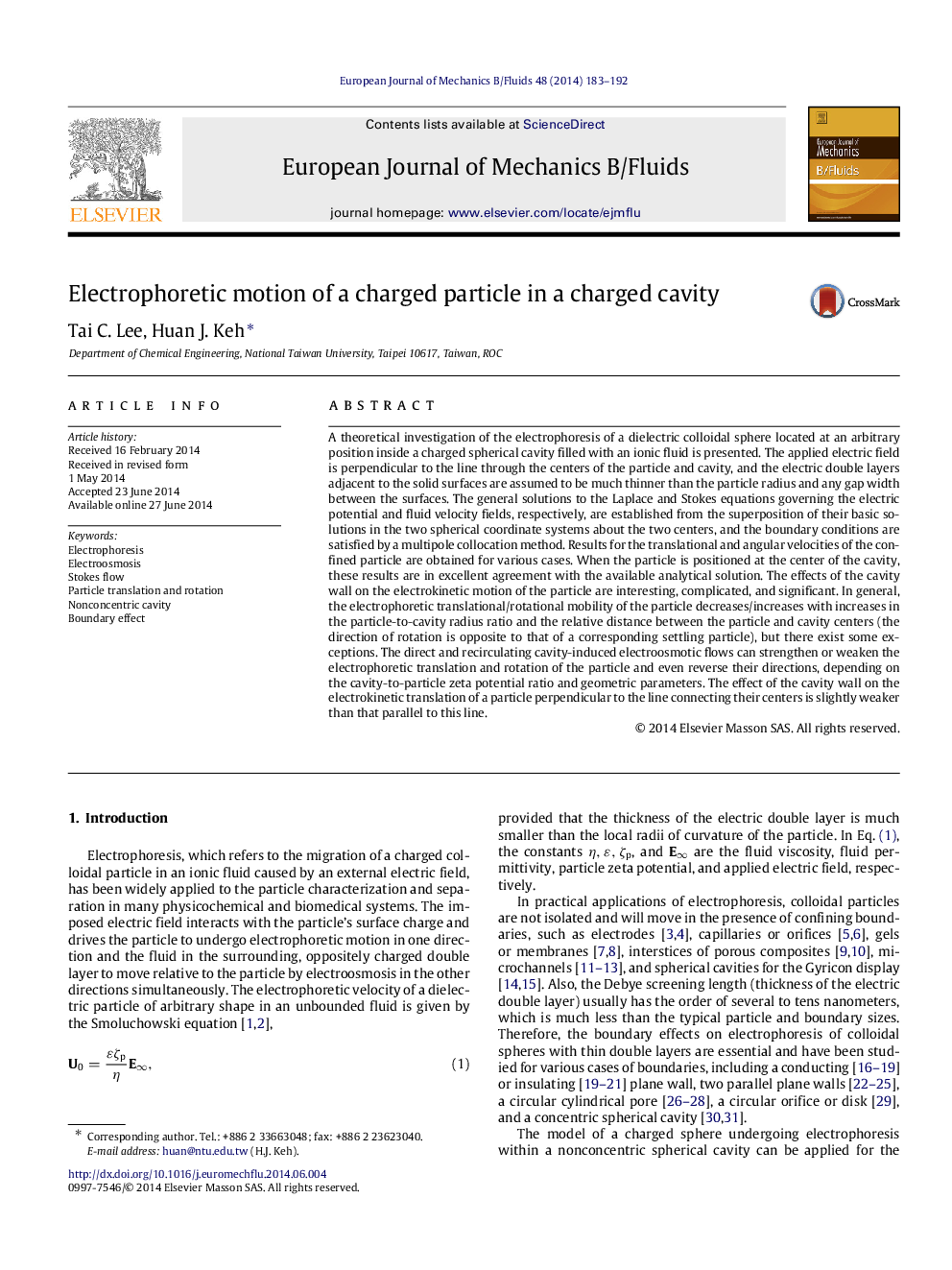| کد مقاله | کد نشریه | سال انتشار | مقاله انگلیسی | نسخه تمام متن |
|---|---|---|---|---|
| 650395 | 1457278 | 2014 | 10 صفحه PDF | دانلود رایگان |
عنوان انگلیسی مقاله ISI
Electrophoretic motion of a charged particle in a charged cavity
ترجمه فارسی عنوان
حرکت الکتروفورز یک ذره باردار در یک حفره شونده
دانلود مقاله + سفارش ترجمه
دانلود مقاله ISI انگلیسی
رایگان برای ایرانیان
کلمات کلیدی
ترجمه چکیده
بررسی نظری الکتروفورز یک کروم کلوئیدی دی الکتریک واقع در موقعیت دلخواه در داخل حفره کروی شارژ پر شده با سیال یونی ارائه شده است. میدان الکتریکی اعمال شده عمود بر خط از طریق مراکز ذره و حفره است و دو لایه الکتریکی مجاور سطوح جامد بسیار نازک تر از شعاع ذره و هر شکاف بین سطوح است. به طور کلی راه حل های معادلات لاپلاس و استوکس که بر اساس پتانسیل الکتریکی و زمینه های سرعت سیال حاکم است، به وسیله قرار دادن راه حل های اساسی آنها در دو سیستم مختصات کروی در مورد دو مرکز، و شرایط مرزی توسط حلقه چندتایی روش. نتایج برای سرعت انتقال و زاویه ای ذرات محدود برای موارد مختلف به دست آمده است. هنگامی که ذره در مرکز حفره واقع شده است، این نتایج در توافق عالی با راه حل تحلیلی موجود موجود است. اثرات دیواره حفره بر حرکت الکتروکینتیک ذرات جالب، پیچیده و قابل توجه است. به طور کلی، تحرک انتقال / چرخش الکتروفورز از ذره کاهش می یابد با افزایش نسبت شعاع ذرات به حفره و فاصله نسبی بین ذرات و حفره های مرکز (جهت چرخش مخالف با یک ذره استقرار مربوطه )، اما برخی از استثنا وجود دارد. جریانهای الکترو مغناطیسی ناشی از حفره مستقیم و مجاور می تواند انتقال الکتروفورز و چرخش ذرات را تقویت یا تضعیف کرده و حتی جهت آن را معکوس کند، بسته به نسبت پتانسیل زتا پوسیدگی به ذرات و پارامترهای هندسی. اثر دیواره حفره بر انتقال الکتروکینتیک یک ذره عمود بر خط اتصال مراکز آنها کمی ضعیف تر از موازی با این خط است.
موضوعات مرتبط
مهندسی و علوم پایه
مهندسی شیمی
جریان سیال و فرایندهای انتقال
چکیده انگلیسی
A theoretical investigation of the electrophoresis of a dielectric colloidal sphere located at an arbitrary position inside a charged spherical cavity filled with an ionic fluid is presented. The applied electric field is perpendicular to the line through the centers of the particle and cavity, and the electric double layers adjacent to the solid surfaces are assumed to be much thinner than the particle radius and any gap width between the surfaces. The general solutions to the Laplace and Stokes equations governing the electric potential and fluid velocity fields, respectively, are established from the superposition of their basic solutions in the two spherical coordinate systems about the two centers, and the boundary conditions are satisfied by a multipole collocation method. Results for the translational and angular velocities of the confined particle are obtained for various cases. When the particle is positioned at the center of the cavity, these results are in excellent agreement with the available analytical solution. The effects of the cavity wall on the electrokinetic motion of the particle are interesting, complicated, and significant. In general, the electrophoretic translational/rotational mobility of the particle decreases/increases with increases in the particle-to-cavity radius ratio and the relative distance between the particle and cavity centers (the direction of rotation is opposite to that of a corresponding settling particle), but there exist some exceptions. The direct and recirculating cavity-induced electroosmotic flows can strengthen or weaken the electrophoretic translation and rotation of the particle and even reverse their directions, depending on the cavity-to-particle zeta potential ratio and geometric parameters. The effect of the cavity wall on the electrokinetic translation of a particle perpendicular to the line connecting their centers is slightly weaker than that parallel to this line.
ناشر
Database: Elsevier - ScienceDirect (ساینس دایرکت)
Journal: European Journal of Mechanics - B/Fluids - Volume 48, NovemberâDecember 2014, Pages 183-192
Journal: European Journal of Mechanics - B/Fluids - Volume 48, NovemberâDecember 2014, Pages 183-192
نویسندگان
Tai C. Lee, Huan J. Keh,
